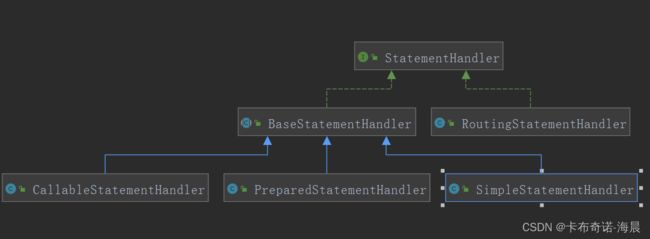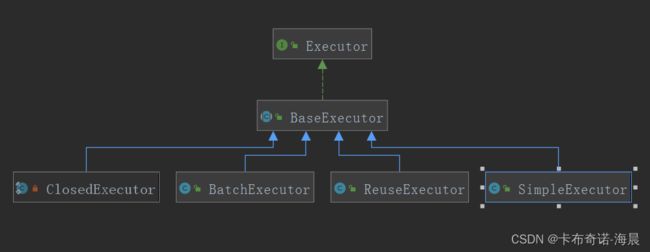盘点MyBatis优良设计之接口及其实现类间的故事
一、前言
接口及其实现类,这种关系大多数开发者多多少少还是知道的。但是面对一个接口多个实现类的设计及其应用,相信绝大多数的开发者还是手足无措的。接口以及抽象类的概念在这里不哆嗦,基础知识务必扎实,才不会在源码的世界里面总是走迷宫。而MyBatis源码里面就有不少关于接口及其实现类的良好设计,在这里笔者罗列一些设计供大家学习参考参考。
不知道大家是否记得上转型的概念,不记得的就得下点功夫了。
二、接口及其实现类的秘密
1、分散new实现类形式
1)接口及其实现类
2)PropertyParser的parse()方法
public static String parse(String string, Properties variables) {
VariableTokenHandler handler = new VariableTokenHandler(variables);
GenericTokenParser parser = new GenericTokenParser("${", "}", handler);
return parser.parse(string);
}3)TextSqlNode中的方法
// 判断是否是动态sql
public boolean isDynamic() {
DynamicCheckerTokenParser checker = new DynamicCheckerTokenParser();
GenericTokenParser parser = createParser(checker);
parser.parse(text);
return checker.isDynamic();
}
@Override
public boolean apply(DynamicContext context) {
GenericTokenParser parser = createParser(new BindingTokenParser(context, injectionFilter));
context.appendSql(parser.parse(text));
return true;
}
private GenericTokenParser createParser(TokenHandler handler) {
return new GenericTokenParser("${", "}", handler);
}2、集中new实现类形式,封装到一个方法里面
2.1、放到集合map形式
1)接口及其实现类
2)XMLScriptBuilder中的parseDynamicTags()与nodeHandlers()方法
List parseDynamicTags(XNode node) {
List contents = new ArrayList();
NodeList children = node.getNode().getChildNodes();
for (int i = 0; i < children.getLength(); i++) {
XNode child = node.newXNode(children.item(i));
if (child.getNode().getNodeType() == Node.CDATA_SECTION_NODE || child.getNode().getNodeType() == Node.TEXT_NODE) {
String data = child.getStringBody("");
TextSqlNode textSqlNode = new TextSqlNode(data);
if (textSqlNode.isDynamic()) {
contents.add(textSqlNode);
isDynamic = true;
} else {
contents.add(new StaticTextSqlNode(data));
}
} else if (child.getNode().getNodeType() == Node.ELEMENT_NODE) { // issue #628
String nodeName = child.getNode().getNodeName();
NodeHandler handler = nodeHandlers(nodeName);
if (handler == null) {
throw new BuilderException("Unknown element <" + nodeName + "> in SQL statement.");
}
handler.handleNode(child, contents);
isDynamic = true;
}
}
return contents;
}
NodeHandler nodeHandlers(String nodeName) {
Map map = new HashMap();
map.put("trim", new TrimHandler());
map.put("where", new WhereHandler());
map.put("set", new SetHandler());
map.put("foreach", new ForEachHandler());
map.put("if", new IfHandler());
map.put("choose", new ChooseHandler());
map.put("when", new IfHandler());
map.put("otherwise", new OtherwiseHandler());
map.put("bind", new BindHandler());
return map.get(nodeName);
} 2.2、非map形式
如下面3.2、3.4.2
三、匹配模式
3.1、instanceof匹配模式
判断左边的对象是否是右边的类型或者子类型。
3.2、if成员变量条件匹配模式
1)接口及其实现类
2)CacheBuilder的setStandardDecorators()方法
// 最后附加上标准的装饰者
private Cache setStandardDecorators(Cache cache) {
try {
MetaObject metaCache = SystemMetaObject.forObject(cache);
if (size != null && metaCache.hasSetter("size")) {
metaCache.setValue("size", size);
}
if (clearInterval != null) {
// 刷新缓存间隔,怎么刷新呢,用ScheduledCache来刷,还是装饰者模式,漂亮!
cache = new ScheduledCache(cache);
((ScheduledCache) cache).setClearInterval(clearInterval);
}
if (readWrite) {
// 如果readOnly=false,可读写的缓存 会返回缓存对象的拷贝(通过序列化) 。这会慢一些,但是安全,因此默认是 false。
cache = new SerializedCache(cache);
}
// 日志缓存
cache = new LoggingCache(cache);
// 同步缓存, 3.2.6以后这个类已经没用了,考虑到Hazelcast, EhCache已经有锁机制了,所以这个锁就画蛇添足了。
cache = new SynchronizedCache(cache);
if (blocking) {
cache = new BlockingCache(cache);
}
return cache;
} catch (Exception e) {
throw new CacheException("Error building standard cache decorators. Cause: " + e, e);
}
}3.3、map的key匹配形式
如:上面的2.1
3.4、封装type匹配模式
3.4.1、switch模式
1)接口及其实现类
2)RoutingStatementHandler构造方法
public RoutingStatementHandler(Executor executor,
MappedStatement ms,
Object parameter,
RowBounds rowBounds,
ResultHandler resultHandler,
BoundSql boundSql) {
//根据语句类型,委派到不同的语句处理器(STATEMENT|PREPARED|CALLABLE)
switch (ms.getStatementType()) {
case STATEMENT:
delegate = new SimpleStatementHandler(executor, ms, parameter, rowBounds, resultHandler, boundSql);
break;
case PREPARED:
delegate = new PreparedStatementHandler(executor, ms, parameter, rowBounds, resultHandler, boundSql);
break;
case CALLABLE:
delegate = new CallableStatementHandler(executor, ms, parameter, rowBounds, resultHandler, boundSql);
break;
default:
throw new ExecutorException("Unknown statement type: " + ms.getStatementType());
}
}3.4.2、if模式
1)接口及其实现类
2)Configuration的newExecutor()方法
//产生执行器
public Executor newExecutor(Transaction transaction, ExecutorType executorType) {
executorType = executorType == null ? defaultExecutorType : executorType;
//这句再做一下保护,囧,防止粗心大意的人将defaultExecutorType设成null?
executorType = executorType == null ? ExecutorType.SIMPLE : executorType;
Executor executor;
//然后就是简单的3个分支,产生3种执行器BatchExecutor/ReuseExecutor/SimpleExecutor
if (ExecutorType.BATCH == executorType) {
executor = new BatchExecutor(this, transaction);
} else if (ExecutorType.REUSE == executorType) {
executor = new ReuseExecutor(this, transaction);
} else {
executor = new SimpleExecutor(this, transaction);
}
//如果要求缓存,生成另一种CachingExecutor(默认就是有缓存),装饰者模式,所以默认都是返回CachingExecutor
if (cacheEnabled) {
executor = new CachingExecutor(executor);
}
//此处调用插件,通过插件可以改变Executor行为
executor = (Executor) interceptorChain.pluginAll(executor);
return executor;
}总结




